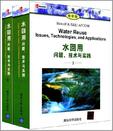水回用(上、下册)
出版时间:2008-7 出版社:清华大学出版社 作者:美国AECOM集团梅特卡夫和埃迪公司 编 页数:1573
Tag标签:无
前言
在21世纪之初,面临各种环境问题,人类清醒地认识到要走可持续发展之路。而发展环境教育是解决环境问题和实施可持续发展战略的根本。高等学校的环境教育,是提高新世纪建设者的环境意识,并向社会输送环境保护专门人才的重要途径。为了反映国外环境类教材的最新内容和编写风格,同时也为了提高学生阅读专业文献和获取信息的能力,我们精选了国外一些优秀的环境类教材,加以影印或翻译,组成大学环境教育丛书。所选教材均在国外被广泛采用,多数已再版,书中不仅介绍了有关概念、原理及技术方法,给出了丰富的数据,也反映了作者不同的学术观点。我们希望这套丛书的出版能对高等院校师生和广大科技人员有所帮助,并为我国的环境教育事业作出贡献。
内容概要
本书介绍水再生、循环与回用方面最新的理论和实践,内容涉及公众健康保护、水质标准和法规、先进技术及实施等问题。 本书包括的重要主题如下: 深入讨论了水再生和回用方面的实践应用,包括实际的案例研究; 介绍了公众健康以及环境保护标准、法规和风险管理方面目前的问题及最新发展; 全面评述了当前的先进处理技术、新的发展及未来的趋势; 着重强调了工艺的可靠性和多重保障的概念; 介绍了水回用系统中小型和分散处理设施; 介绍了水回用项目开发中的规划和实施问题。 本书可用作环境工程、市政工程等专业高年级本科生和研究生的教材,也是相关领域科技人员的必备案头书。
作者简介
编者:(美国)美国AECOM集团梅特卡夫和埃迪公司
书籍目录
PrefaceAcknowledgmentsForewordPart 1 Water Reuse:An Introduction 1 Water Issues: Current Status and the Role of Water Reclamation and Reuse 2 Water Reuse: Past and Current PracticesPart 2 Health andEnvironmental Concerns in Water Reuse 3 Characteristics of Municipal Wastewater and Related Health and Environmental Issues 4 Water Reuse Regulations and Guidelines 5 Health Risk Analysis in Water Reuse ApplicationsPart 3 Technologies and Systems for WaterReclamation and Reuse 6 Water Reuse Technologies and Treatment Systems:An Overview 7 Removal of Constituents by Secondary Treatment 8 Removal of Residual Particulate Matter 9 Removal of Dissolved Constituents with Membranes 10 Removal of Residual Trace Constituents 11 Disinfection Processes for Water Reuse Applications 12 Satellite Treatment Systems for Water Reuse Applications 13 Onsite and Decentralized Systems for Water Reuse 14 Distribution and Storage of Reclaimed Water 15 Dual Plumbing SystemsPart 4 Water Reuse Applications 16 Water Reuse Applications: An Overview 17 Agricultural Uses of Reclaimed Water 18 Landscape Irrigation with Reclaimed Water 19 Industrial Uses of Reclaimed Water 20 Urban Nonirrigation Water Reuse Applications 21 Environmental and Recreational Uses of Reclaimed Water 22 Groundwater Recharge with Reclaimed Water 1245 23 Indirect Potable Reuse through Surface Water Augmentation 24 Direct Potable Reuse of Reclaimed Water Part 5 Implementing Water Reuse 25 Planning for Water Reclamation and Reuse 26 Public Participation and Implementation IssuesAppendixesIndexes
章节摘录
Heavy metals Some heavy metals such as cadmium, copper, molybdenum, nickel, and zinc may accumulate in crops to levels that are toxic to consumers of the crops。 Heavy metals in reclaimed water that has received at least secondary treatment are generally within acceptable levels for most uses; however, if industrial wastewater pretreatment pro- grams are not enforced, certain industrial wastewaters discharged to a municipal wastewater collection system may contribute significant amounts of heavy metals。Hydrogen ion concentration,pH The pH of wastewater affects disinfection efficiency, coagulation, metal solubility, and alkalinity of soils。 Normal pH range in municipal wastewater is 6。5 to 8。5, but some industrial wastes may have pH levels well outside of this range。Trace constituents Pharmaceutically active compounds (PhACs), endocrine disrupting compounds (EDCs), personal care products, and other trace constituents have been implicated in adverse effects to frogs, fish, and other aquatic animals。 Although a number of trace constituents are removed via conventional treatment, low concentrations of some of them may be present in wastewater effluent。 The health risks associated with low con- centrations of many of these compounds are unknown; however, they may present a health concern if reclaimed water is used for potable purposes or if reclaimed water used for irrigation or other uses makes its way into groundwater or surface supplies。Disinfection byproducts The reaction of chemical oxidants such as chlorine and ozone with organics in water can create a wide range of disinfection byproducts (DBPs), some of which may be harmful to human health if ingested over the long term。 The principal DBPs of concern in drinking water are the trihalomethanes, haloacetic acids, bromate, and haloacetoni- triles (see Chap。 11)。Total dissolved solids, TDS A measure of the total ionic constituents in water。 High TDS concentrations are of concern in a number of reuse applications including agricultural and landscape irrigation, and industrial applications (see Chaps。 17。 18。 and 19)。
编辑推荐
《水回用问题、技术与实践(套装全2册)》可用作环境工程、市政工程等专业高年级本科生和研究生的教材,也是相关领域科技人员的必备案头书。
图书封面
图书标签Tags
无
评论、评分、阅读与下载
用户评论 (总计7条)
- 不错
环境类的经典图书 - 想了解的内容都包括了,还有中文的导读标签,看起来相当轻松。
- 阅读此书不仅可以增长专业知识,对于英语的提高也是大有益处
- 编的还是不错的,值得学习。
- 此书内容广泛,深入浅出,以美国的水回用为例介绍了关于废水回用的问题、技术及应用。很好。值得买
- 名家经典,与废水工程 处理及回用是姐妹作
- 清华大学出版社把这本书搞得有点不伦不类,翻译了一些标题,可能是为了帮助理解,但感觉排版很乱,当然,不影响内容吧。
